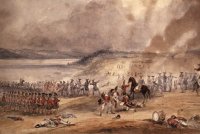
Worksheets and No Prep Teaching Resources
Reading Comprehension Worksheets
Canadian Theme Unit

Canadian Theme Unit
 Worksheets and No Prep Teaching Resources Reading Comprehension Worksheets Canadian Theme Unit |
 Canadian Theme Unit |
| edHelper's suggested reading level: | grades 6 to 7 | |
| Flesch-Kincaid grade level: | 6.95 |
|
The Seven Years War
By Mary Lynn Bushong |

|
 1 In the United States this war is called the French and Indian War, but in Canada, it goes by the European name, the Seven Years War. It was fought between the British and the French for control of the eastern half of North America.
1 In the United States this war is called the French and Indian War, but in Canada, it goes by the European name, the Seven Years War. It was fought between the British and the French for control of the eastern half of North America. |
Create Weekly Reading Books
Prepare for an entire week at once! |
| Leave your feedback on The Seven Years War (use this link if you found an error in the story) |
 |
Canadian Theme Unit
|
 |
Social Studies
|